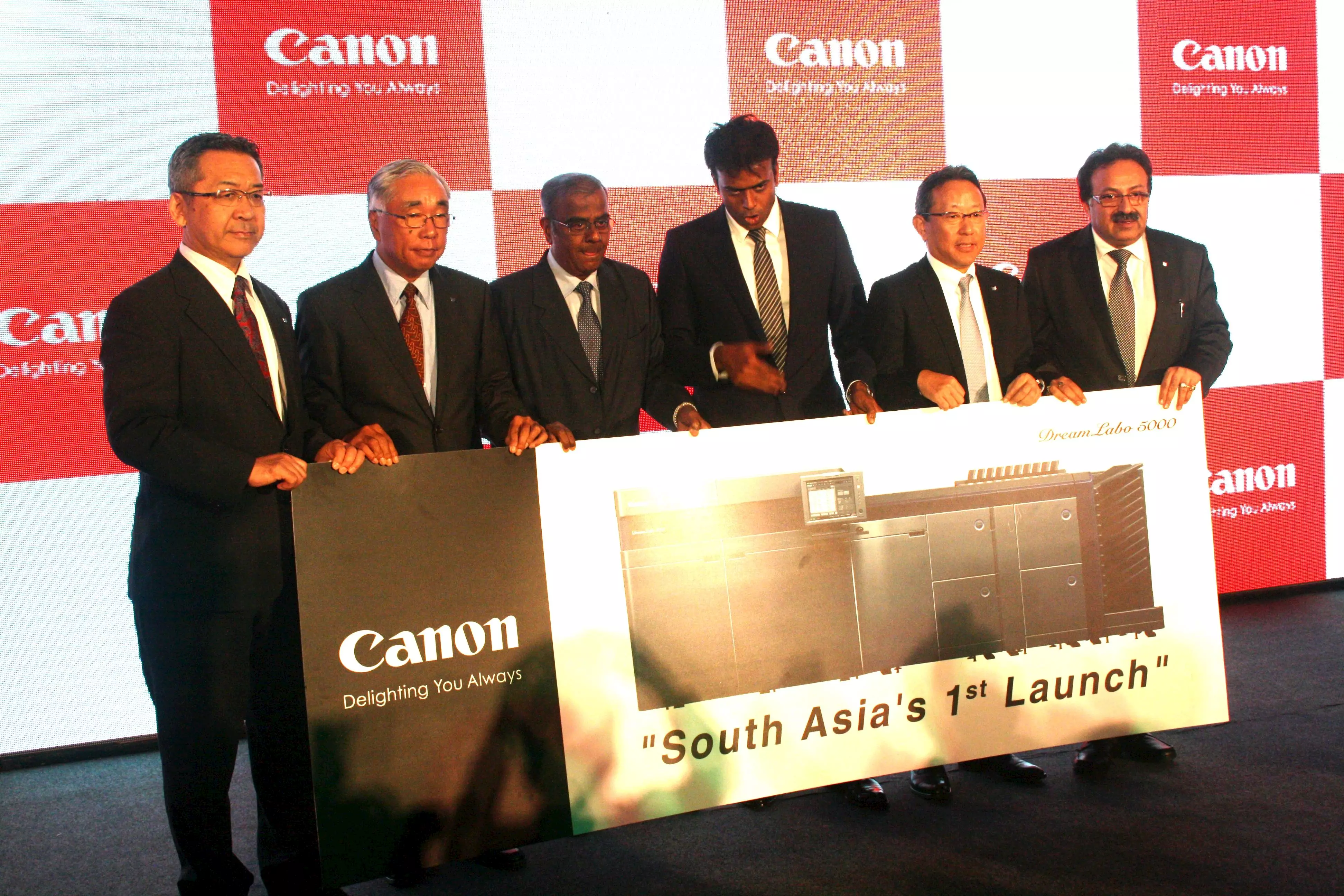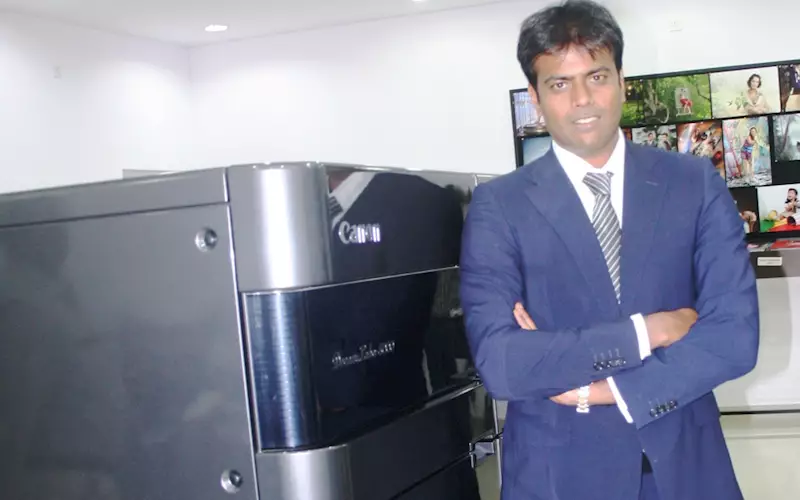Anand Sukumar, the managing partner of G K Vale said, "This is a radical shift from the standard prints that a digital press like HP Indigo or IGen 3 produces, to a premium HD quality. This is the reason, the DreamLabo is more than appropriate for our line of business."
The DreamLabo which has been running for two months at GK Vale has notched up healthy numbers. More importantly, it has phased out some of the legacy silver halide units. Sukumar during a Q&A session admitted, that the performance and premium quality has bolstered business; and there is "every possibility that GK Vale will add a second DreamLabo by April 2014."
The DreamLabo technology
On the sidelines of the official press conference, PrintWeek India spoke to Takao Haldo, senior general manager and the man who is credited for the commercial inkjet products operation of Canon in Japan. He explained that the DreamLabo uses Canon’s thermal Full-photolithography Inkjet Nozzle Engineering (FINE) technology". He said the key word is "engineering".
Interestingly this technology is similar to that found on Canon's Pixma range of consumer printers and the imagePrograf wide-format machines. What makes a difference is, and print samples are a testimony to this, is how FINE technology has been integrated into the heads into the 305mm-wide high-density array that enables a resolution of 2,400x1,200dpi." The duplexing web-fed press comes with an onboard RIP and trimmer, enabling it to process 600dpi 8-bit RGB files, which it converts to 2,400dpi, and output trimmed prints.
Quality HD pictures

The DreamLabo’s key rivals are the high-end silver halide systems, but in the digital field, its foes are commercial engines with photo applications. But the DreamLabo scores high on the quality front. The work, especially on metallic paper, is cutting-edge.
At the moment, it runs only four types of specially developed photo stocks which are sourced from Canon. This is one of the reasons, the price is 50% higher that alternative technologies. But Anand Sukumar said, "Customers are very happy with the quality and in addition to paying for it; some of them are returning for repeat jobs."
A quick look at the samples during the press conference and indeed the work produced at GK Vale, indicates that the DreamLabo's focus is quality. And the machine’s apparently modest speed is fairly respectable. Sukumar says, it has replaced a raft of their silver halide devices and is capable of 1,000 pages per hour which is equal to 50 photo albums per hour.
DreamLabo: A workhorse
When we visited the GK Vale unit we saw during demos that the device machine offers a double ink tank system for on-the-fly replenishment and a standard double magazine paper feeder, which can be upgraded to a quadruple system. It uses a seven-colour inkset, CMYK plus photo magenta, photo cyan and grey.
The other key aspect of the DreamLabo is, "it's a workhorse". The GK Vale team testified that it runs 15-16 hours at a stretch. This makes it ideal for the 24/7 operation, which is what traditional photo labs are expected to provide.

This device is priced at half a million dollars; and aimed at the top photo lab chains in India who have serious volume. As Alok Bharadwaj, the executive vice president of Canon India, said during a 30 minute presentation on the photo space, “India is a Rs 3,000 crore photo printing industry. A major portion of the share is accrued from wedding albums and travel vacation photos. While there is tremendous change in photo capturing, the printing art is still dominated with conventional technology. Conventional silver halide technology is just too old and the digital-offset alternative is not matching customer expectations. There was enormous scope of value creation in this space. Our partners (GK Vale) call the new Dreamlabo 5000 prints as HD (high definition) prints."
Bharadwaj stated, "Canon plans to start with Rs 15 crore coming out of this domain in 2014. (We believe) it has a potential to create a Rs 100 crore business stream in five years.”
DREAM Labo 5000 SPECIFICATIONS
Speed 16.6 duplex A4 pages per minute (40x 6x4" photos/min single sided)
Max resolution 2,400x1,200dpi
Min print size 89x89mm
Max print size 635x305mm
Substrate range 165-275gsm
Web width 127-305mm
Footprint 3.4x1.6m (4.1x1.6m with optional quadruple magazine system)
Weight 2.5 tonnes

 The DreamLabo’s key rivals are the high-end silver halide systems, but in the digital field, its foes are commercial engines with photo applications. But the DreamLabo scores high on the quality front. The work, especially on metallic paper, is cutting-edge.
The DreamLabo’s key rivals are the high-end silver halide systems, but in the digital field, its foes are commercial engines with photo applications. But the DreamLabo scores high on the quality front. The work, especially on metallic paper, is cutting-edge. This device is priced at half a million dollars; and aimed at the top photo lab chains in India who have serious volume. As Alok Bharadwaj, the executive vice president of Canon India, said during a 30 minute presentation on the photo space, “India is a Rs 3,000 crore photo printing industry. A major portion of the share is accrued from wedding albums and travel vacation photos. While there is tremendous change in photo capturing, the printing art is still dominated with conventional technology. Conventional silver halide technology is just too old and the digital-offset alternative is not matching customer expectations. There was enormous scope of value creation in this space. Our partners (GK Vale) call the new Dreamlabo 5000 prints as HD (high definition) prints."
This device is priced at half a million dollars; and aimed at the top photo lab chains in India who have serious volume. As Alok Bharadwaj, the executive vice president of Canon India, said during a 30 minute presentation on the photo space, “India is a Rs 3,000 crore photo printing industry. A major portion of the share is accrued from wedding albums and travel vacation photos. While there is tremendous change in photo capturing, the printing art is still dominated with conventional technology. Conventional silver halide technology is just too old and the digital-offset alternative is not matching customer expectations. There was enormous scope of value creation in this space. Our partners (GK Vale) call the new Dreamlabo 5000 prints as HD (high definition) prints."










 See All
See All